March 1796
2 March 1796 – General Napoleon Bonaparte got the command in chief of the Army of Italy.
9 March 1796 – He married Joséphine de Beauharnais at the town hall of the 2nd arrondissement of Paris, rue d'Antin .
11 March 1796 – Departure for the army.
27 March 1796 – Arrival at Nice, assumption of command and first proclamation to the army: Soldiers, you are naked, malnourished... I wish to lead you into the most fertile plains of the world
.
29 March 1796 – Bonaparte got arrested the commander of a battalion who refused to march on. He and the main chiefs of the mutiny would go to the war council.
April 1796
2 April 1796 – Napoleon Bonaparte reached Menton: the Campaign in Italy began.
10 April 1796 – Beginning of the offensive against the Austrian army.
12 April 1796 – Battle of Montenotte.

13 April 1796 – Battle of Millesimo.
14 April 1796 – Entry in Cosseria.
15 April 1796 – Victory of Dego .
21 April 1796 – Battle of Mondovi. Napoleon Bonaparte entered the city in the evening.
22 April 1796 – Bonaparte declared on his agenda that he reprouved the looting committed by a few French soldiers.
28 April 1796 – In Cherasco [44.65079, 7.85834], Bonaparte signed an armistice with the envoys of the King of Sardinia without reporting it to the French Directory.
29 April 1796 – Letter to Josephine asking her to join him.
May 1796
7 May 1796 – Napoleon Bonaparte entered Piacenza after having passed through Po River.
9 May 1796 – An armistice was signed with the duke of Parma.
10 May 1796 – Victory of Lodi. Bonaparte was "appointed as corporal" by his soldiers.
11 May 1796 – He requested the Directory to constitute a commission in charge of choosing the works of art to be taken from Italian museums.
14 May 1796 – He wrote to the Directory refusing to share his command with François Kellermann.
15 May 1796 – Bonaparte entered Milan. In Paris, the envoys of the King of Sardinia signed a peace treaty, whose clauses were more severe than those of the armistice (loss of Savoy and Nice in particular).
16 May 1796 – Bonaparte ordered the communes of Lombardy to submit to the French Republic within twenty-four hours.
17 May 1796 – The duke of Modena got an armistice.
18 May 1796 – Bonaparte announced the leaving for Paris of twenty paintings to the Directory including a few of Correggio and Michelangelo.
24 May 1796 – Insurrection of the Milanese population.
25 May 1796 – Napoleon Bonaparte repressed the movement. The village of Binasco was burnt. Proclamation to the inhabitants of Lombardy to to threaten them with terrible reprisals.
26 May 1796 – The municipality of Pavia was shot down for having refused to surrender the city, which was left to be looted.
27 May 1796 – Entry in Brescia.
29 May 1796 – Bonaparte indicated to the Republic of Venice that the French army would be entering into its territory soon.
31 May 1796 – Bonaparte personally commanded the repression against the farmers of Tortona.
June 1796
1st June 1796 – Jean Lannes set fire to the village of Arquata.
3 June 1796 – Entry of the French in Verona .
6 June 1796 – An armistice was signed with the Kingdom of Naples.
7 June 1796 – Napoleon Bonaparte met with the Pope Pius VI's envoy.
11 June 1796 – Proclamation to the army, against looting.
12 June 1796 – Entry of the French army in the Papal States.
16 June 1796 – Letter to the governor of Novi, enjoining him to cooperate.
21 June 1796 – Bonaparte announced the dispatch of paintings, in particular of Raphael (Raffaello Sanzio da Urbino), to the Directory.
23 June 1796 – Signing of an armistice in Bologna with the Holy See.
27 June 1796 – Livorno was occupied.
30 June 1796 – Godefroy Redon de Belleville, consul of the French Republic in Livorno, got the shops belonging to English, Russian and Austrian subjects sealed. Insurrection of Lugo.
July 1796
2 July 1796 – Napoleon Bonaparte announced a fresh dispatch of silverware, jewellery and liquid assets to the Directory.
6 July 1796 – Lugo was recaptured and punished.
25 July 1796 – Pierre-Louis Roederer, in the Journal de Paris, demanded for a control of tax collections and the use of the levied contributions in enemy country, without quoting the name of Bonaparte.
26 July 1796 – Offensive of Dagobert Sigmund von Wurmser, the new Austrian chief general.
28 July 1796 – Napoleon Bonaparte left Josephine, who had just arrived recently, and returned to the army.
29 July 1796 – The Austrians recaptured Brescia.
30 July 1796 – Bonaparte lifted the siege of Mantua in order to reach right in front of the ranks of Wurmser.
31 July 1796 – The Austrians recaptured Mantua; they marched over Castiglione delle Stiviere.

August 1796
3 August 1796 – Victory of André Masséna at Lonato.
5 August 1796 – Victory of Charles Pierre François Augereau at Castiglione.
September 1796
4 September 1796 – Victory of Roveredo.
8 September 1796 – Battle of Bassano [Bassano del Grappa], a new French victory.

14-15 September 1796 – Battle of San Giorgio di Mantova.
17 September 1796 – Creation of the Cispadane Republic, comprising Modena, Reggio, Bologna and Ferrara.
19 September 1796 – Lazare Carnot to Napoleon Bonaparte : Our hopes were surpassed by the victory of Bassano. Such glory for you, immortal Bonaparte!
.
20 September 1796 – Charles-Maurice de Talleyrand-Périgord returned from America.
25 September 1796 – Napoleon Bonaparte created the company of guides (136 men), core of the future Imperial guard.
October 1796
2 October 1796 – Napoleon Bonaparte offered peace to the Emperor of Germany, Francis II.
8 October 1796 – Bonaparte proclaimed the independence of the States of the Duke of Modena.
9 October 1796 – Genoa accepted to shut its ports to the British and pay a tribute, thereby getting a treaty with France.
10 October 1796 – Naples also undertook to pay.
25 October 1796 – The commissioners of the government received orders to get silverware from the churches of Italy sold, in aid of the French army.
November 1796
1st November 1796 – New Austrian offensive.
6 November 1796 – Masséna failed in Bassano...
12 November 1796 –... and so did Bonaparte in Caldiero.
17 November 1796 – Victory of Arcole, after three days of battle.
December 1796
5 December 1796 – Proclamation of the constitution of the Cispadane Republic.
6 December 1796 – The city of Carrara tried to revolt, repression was immediate.
27 December 1796 – The patriots of Bergamo and Ferrara came to an understanding and formed a Cisalpine Republic.